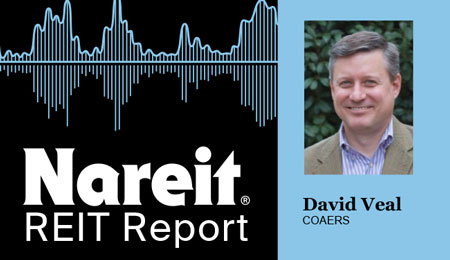 David Veal, chief investment officer for the City of Austin Employee’s Retirement System (COAERS), joined guest host Meredith Despins, Nareit senior vice president, investment affairs, for a special edition of the REIT Report to discuss how investing in a completion portfolio using REITs is delivering value to the pension system’s real estate investment portfolio.
David Veal, chief investment officer for the City of Austin Employee’s Retirement System (COAERS), joined guest host Meredith Despins, Nareit senior vice president, investment affairs, for a special edition of the REIT Report to discuss how investing in a completion portfolio using REITs is delivering value to the pension system’s real estate investment portfolio.
Pension funds have long recognized the important role real estate plays in diversified investment portfolios. However, over the past 20 years, the real estate economy has expanded beyond the property sectors institutional investors have traditionally invested in—like retail, office, residential, or industrial. Today’s REIT industry reflects that evolution and offers investors access to a diversity of property types, including the new economy property sectors like infrastructure, cell towers, data centers, and networked logistics properties that house the growing digital economy. This rise of 21st century real estate has prompted institutional investors—such as COAERS—to adopt a portfolio completion strategy. A portfolio completion strategy is a tool investors have to invest in property sectors, including new economy sectors, that complement the traditional real estate property types in order to achieve more robust diversification, boost portfolio investment returns, and dampen volatility.
COAERS oversees a $3 billion fund that’s part of a defined benefit plan. The fund’s overall investment objective is to produce the highest possible returns for the risk budget that the System’s Board has set. With a 7% assumed rate of return target, that translates, in today’s market, to an emphasis on growth-oriented assets including real estate. The fund has about a 10% target to real estate. Previously, the real estate allocation was held through a single private market fund focused on only core U.S. real estate, but in 2019 they realized they were missing out on a number of newer property types.
“[My colleague] helped us realize that over the last 16 years, the fund could have done about 180 basis points better per year with a portfolio of REITs that would have also been more diversified and more liquid than what we held. And much of that performance improvement would have come from exposure to those newer property types, such as data centers,” Veal said.
Given the Board’s prioritization of liquidity, diversification, and cost-effectiveness, Veal’s team realized that making some changes to the portfolio would be appropriate and even necessary. Ultimately, they decided to trim the core U.S. fund essentially in half and reassign those dollars to a completion portfolio of REITs. “That strategy would allow us to capture those newer property types, increase the liquidity of our portfolio, and reduce our overall fees in the real estate portfolio dramatically,” he said.
COAERS started with the FTSE Nareit Composite Index and, working with FTSE-Russell, developed a custom index tailored to their needs. The completion portfolio strategy was implemented in December of 2019. Veal acknowledged it’s been an “eventful” year for real estate with the pandemic, but added that these challenges have only highlighted the benefits of a highly customizable allocation to sector.
Veal encouraged institutional investors to “look critically and strategically at what’s in their portfolios and ask whether the current portfolio still makes sense in light of everything that’s happening in the world and the way things have changed over the last decade or two.”
“It’s my view that positioning your portfolio for the future is always a challenging task, but in my experience tailoring it to your needs has never been easier than it is today,” he added.